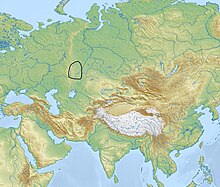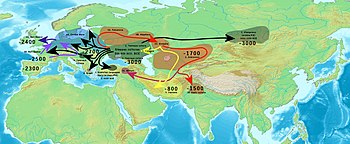辛塔什塔文化
外观
 | |
| 时期 | 青铜器时代 |
|---|---|
| 时间 | 2200–1750 BCE |
| 典型代表 | Sintashta |
| 主要遗址 | Sintashta Arkaim Petrovka |
| 特色 | Extensive copper and bronze metallurgy Fortified settlements Elaborate weapon burials Earliest known chariots |
| 先前文化 | Corded Ware culture Poltavka culture Abashevo culture |
| 继承文化 | Andronovo culture, Srubnaya culture, Vedic culture |
辛塔什塔文化 (英语:Sintashta culture)是位于南乌拉尔山脉一带的青铜器文化。存在于西元前2200~西元前1750年。该文化影响范围包含今俄罗斯奥伦堡州、哈萨克北部。[1]
辛塔什塔文化被认为可能与印度-伊朗语族的起源有关,是透过原始印欧人东进而形成的。印度-伊朗语族是印欧语系的一个主要分支。[2]辛塔什塔文化挖掘出了已知最早的双轮战车,可能是双轮战车传播的源头。该文化亦已擅长金属锻造技术知名。[3]
辛塔什塔文化之后衍生出安德罗诺沃文化。
图片
[编辑] |
参考资料
[编辑]- ^ Lindner 2020,第362页,"The publication of new radiocarbon data series from selected burial sites in the South-eastern Urals has helped to establish a much more accurate chronology for the late Middle Bronze Age Sintashta-Petrovka complex".
- ^ Anthony 2007,第408–411页
- ^ Chechushkov, I.V.; Epimakhov, A.V. Eurasian Steppe Chariots and Social Complexity During the Bronze Age. Journal of World Prehistory. 2018, 31 (4): 435–483 [2023-08-31]. S2CID 254743380. doi:10.1007/s10963-018-9124-0. (原始内容存档于2022-12-06).
